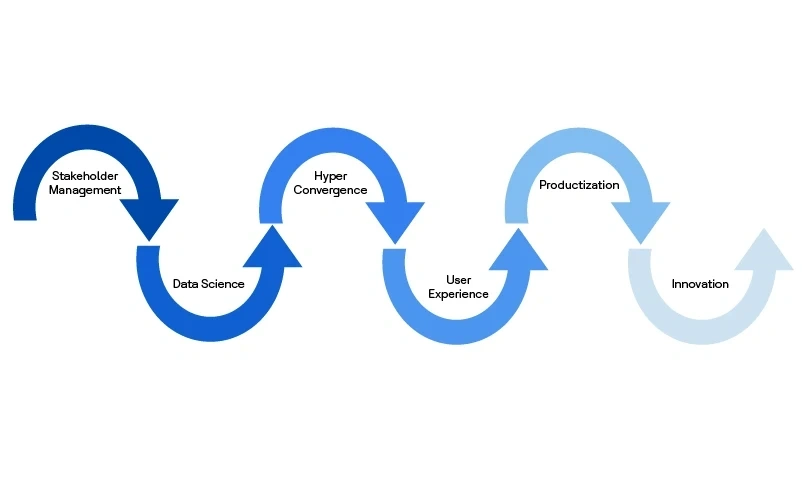Post the cold-war, researchers coined the term, “VUCA,” which stands for Volatility, Uncertainty, Complexity and Ambiguity. These are the four characteristics that were predicted to describe the interactions in society and businesses. Now, more than ever before, the predictions proved right.
To prepare their operations for VUCA, organizations are directing large capacities and funds into transformative programs, such as Industry 4.0 (I4.0) and beyond to make operations resilient.
Industry NeXT is HCLTech’s framework for bundling our capabilities, propositions, solutions and partner ecosystems to support our customers and their drive toward resilience that makes them expansive, adaptive and future proof.
Key characteristics of resilient organizations are:
- Expansive: Cater for the exponential growth of smart and connected assets, industrial protocols, factories, across the globe by providing real time insights and decision support from edge to cloud.
- Adaptive: The ability to adapt to the growing complexity and evolving business models and concepts by using a scalable and industrialized approach to adopting digital levers and by bridging traditional barriers between the OT and the IT world
- Future-proof: Converging towards pervasive innovation by the help of composable, modular architecture which allows future technology innovations to integrate or to build on top of it
Currently, we have delivered more than 750 large-scale transformations across 6 key pillars of Industry NeXT for and together with our customers.
6 pillars of Industry NeXT
- Cognitive Supply Chain
- Connected Data Platform
- Digital Manufacturing
- Immersive Technology Adoption
- OT/IT Convergence
- Sustainability
The value that we returned to our customers easily exceeded $10 billion — mainly across operational benefits, revenue increase, improved customer intimacy, sustainability or worker and stakeholder centricity.
With many customers, we have been a part of their operations digital transformation for years. So, we recently conducted a systematic review of our engagement to filter out the do’s and don'ts we learned.
The results are six key lessons learned that we have incorporated into our transformation approach and definitely help us to avoid major risks on the path toward resilience.

- Stakeholder management:
We have realized that stakeholder management is not only necessary, but a key to driving adoption and lasting benefits. This would involve several people being onboarded from different parts of the company’s business divisions, IT and supply chain, to ensure proper alignment within the different parts of the organization, no friction and easy adoption of operations digital transformation initiatives helping companies implement their business goals faster. - Data science:
“Data is the new oil” and insights are what the world wants. Data, like oil, is not useful in its raw state. It needs to be refined, processed and turned into something useful; its intrinsic value lies in its potential. So, the world of AI, Generative AI (GenAI) and other data science aspects play a big role in jumping ahead of the competition by creating analytics and insights that give organizations their competitive edge over data silos. - Hyper convergence:
The world is moving to an integrated and intelligent model with data and platforms coming together to give a seamless and end-to-end business view and experience for users across Engineering Technology (ET), Operational Technology (OT) and Information Technology (IT). The approach to how data is harvested decides the scalability with interoperability of the data and how converged platforms enable the data to flow to various parts of the business — making real-time decisions and agile businesses. - User experience:
We know user centricity is the driving adoption and the customer is the King. To not only satisfy, but to give a superior experience, every product in the modern market is designed to keep users in mind. This finally drives business, adoption, profitability and market share. Therefore, whether it is the product, services or any other offering, user experience has become the central criteria for determining a company’s digital roadmap and initiatives. - Productization:
With IP monetization strategies, ‘productized’ solutions bundled with services are increasingly becoming a product company’s strategy for addressing the market demand. While certain technologies, like equipment monitoring and tracking, have flourished, we expect technologies, like additive (3D) printing, digital twin, augmented reality, etc., to grow exponentially in the future and help release value from large enterprises and SMB sectors. - Innovation:
The key to how you can make things better, faster, cheaper and more meaningful is through innovation. Starting from on-field equipment (i.e., sensors, SCADA and PLCs, MES and HMI) to Layer 3 and DMZ as well as hardware, software, automation, convergence, data and systems, there is innovation happening at every step, enabling businesses to be more proactive and agile to respond to quickly changing business scenarios.
We adjusted our “agile stratecution” model that we use for a value-based transformation and are willing to share our framework, experience and capabilities with you.


